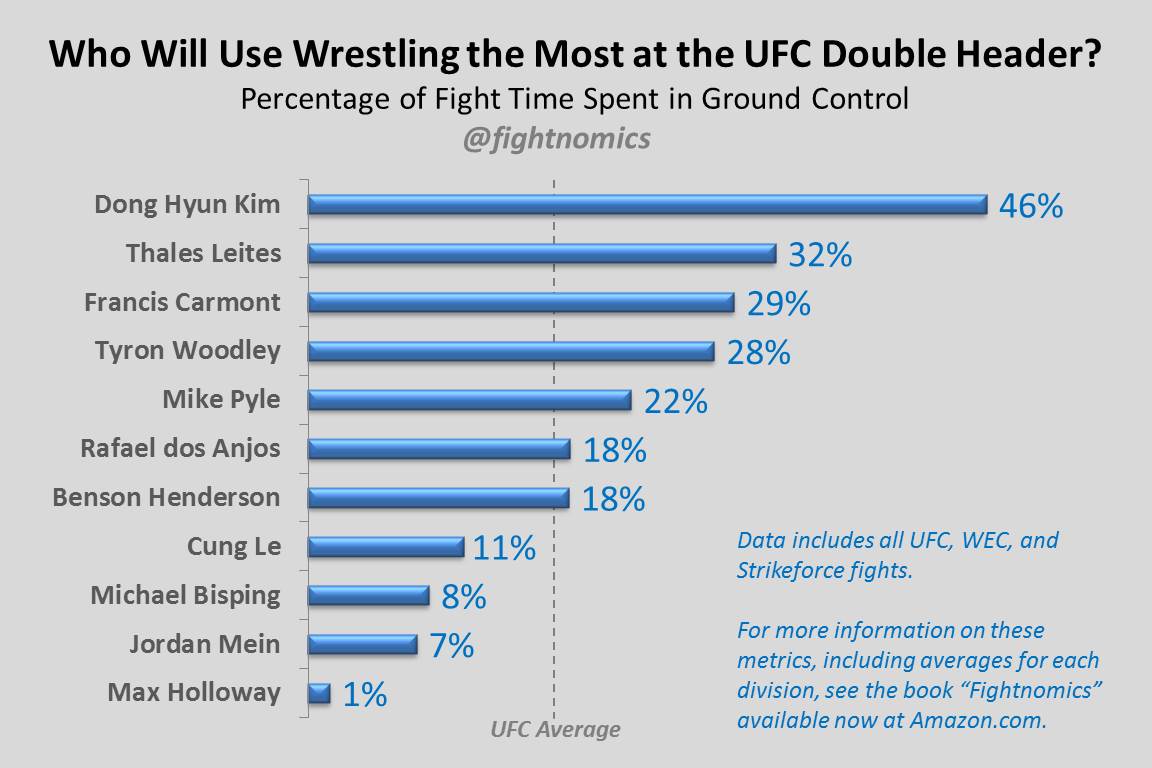It’s Double Header time once again for the UFC: two events in less than 24 hours, on two sides of the planet. No problem for the UFC, although a little trickier for fans who might be interesting in watching both events without missing a night of sleep! But “fan” is short for fanatic, right? You were made for weekends like this. Unlike FOX and PPV cards which often are loaded with heavy hitters, this weekend’s fight cards offer a hefty portion of successful grapplers. So let’s take a look at a new metric and see which fighters have relied on their wrestling the most to date by looking at how much time they spent on the mat in control. Why ground control? Takedown success rate could be misleading if a fighter rarely uses takedowns, but landed with success when he did. Similarly, attempting a lot of takedowns could be a bad thing if it means you’re not converting them. And even if you get an opponent down, you still need to keep him there to get value from the wrestling. So what we should really care about is simply who is actually using their wrestling to stay in control on the mat – and for how long. Here’s how the fighters stack up in terms of their average Percentage of Fight Time Spent in Ground Control.
The historic UFC average for this metric is currently about 17%, but the average varies for fighters of varying weight classes. This is different from the Share of Ground Time in Control stat on the Uber Tale of the Tape. For more historical grappling metrics, get the book “Fightnomics” at Amazon.
The clear winner on this list is Dong Hyun Kim, who has definitely utilized his judo base to get fights to the mat, then leveraging his large frame to keep opponents there. Throughout is very long UFC career, he spends almost half of all his fight minutes on the ground controlling opponents. No one else on this list is close. Kim’s wrestling was a key to his prior victories, but this weekend he’s matched up with another strong wrestler in Tyron Woodley, making a for an interesting stylistic battle in the co-main event of the first card. In fact, both fighters have a 90% total ground control stat, meaning they’ve only been on their backs or otherwise controlled for a mere 10% of their total time on the ground. And in case you’re wondering, while both fighters have excellent takedown defense, Woodley’s is a little higher. Thales Leites and Francis Carmont both have big frames for their division, and are quick to attempt takedowns even if their success rates aren’t very high. Leites certainly has the better submission credentials, so it will be interesting if Carmont has to change up the game plan in this matchup. Mike Pyle has used his grappling fairly often to date, but his opponent Jordan Mein has not. With a 14-year age gap between them, the striking might favor the young gun Mein. Look for Pyle to attempt takedowns early. The main event at Fight Night 49 pairs two guys accustom to getting the better of their opponents on the mat, and have spent a good share of time controlling opponents on the ground. This wrestling battle will be interesting to watch, but may start to favor Henderson as the fight goes on and his conditioning starts to set him apart from Dos Anjos. In the main event of the Macau card, neither Cung Le nor Michael Bisping are likely to use grappling. If we get a striker’s duel – and I assume we all hope that’s what will happen – it will be Le precision and power versus Bisping’s range, pace and conditioning. Who should you not expect to go for the takedowns? Clearly, the answer is Max Holloway, who has been so successful with his long range striking that he hasn’t needed wrestling. Due to a last minute opponent change, let’s just hope he gets to fight. Who’s wrestling will be the difference this weekend? With a lot of fights to keep track of, at least we can be thankful none are on pay-per-view. Enjoy the action, and get some sleep. “Fightnomics” the book is now available on Amazon! Follow along on Twitter for the latest UFC stats and MMA analysis.
